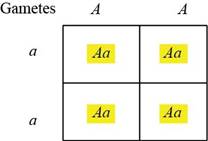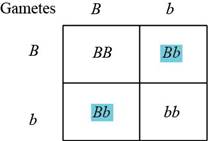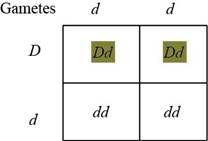
Concept explainers
To describe:
The proportion of offspring being heterozygous for all the genes.
Concept introduction:
Mating between two ferns, one having genotype
Explanation of Solution
Tabular representation:

Table.1: The progeny obtained by crossing AA and aa.

Table.2: The progeny obtained by crossing Bb and Bb.

Table.3: The progeny obtained by crossing Cc and CC.

Table.4: The progeny obtained by crossing dd and Dd.

Table.5: The progeny obtained by crossing Ee and ee.
Explanation:
The genotypes for the first traits are AA and aa. The gametes formed by these will be as follows:
The offspring obtained from crossing can be observed in the Punnett square in Table.1: “The progeny obtained by crossing AA and aa”. All the offspring would be heterozygous. The probability of having heterozygous offspring from first trait is
The genotypes for the second traits are Bb and Bb. The gametes formed by these will be as follows:
The probability of offspring produced from crossing can be observed in the Punnett square in Table.2: “The progeny obtained by crossing Bb and Bb”. There will be
The genotypes for the third traits are Cc and CC. The gametes formed by these will be as follows:
The offspring obtained from crossing can be observed in the Punnett square in Table.3: “The progeny obtained by crossing Cc and CC”. There will be
The genotypes for the fourth traits are dd and Dd. The gametes formed by these will be as follows.
The offspring obtained from crossing can be observed in the Punnett square in Table.4: “The progeny obtained by crossing dd and Dd”. There will be
The genotypes for the fifth traits are Ee and ee. The gametes formed by these will be as follows.
The offspring obtained from crossing can be observed in the Punnett square in Table.5: “The progeny obtained by crossing Ee and ee”. There will be
The probability of offspring heterozygous for all the traits can be calculated using the product rule that is by multiplying individual probabilities of heterozygotes for each trait. The probability of offspring heterozygous for all genes can be calculated as follows:
The probability of offspring heterozygous for all the genes is
Want to see more full solutions like this?
Chapter 10 Solutions
BIOLOGY:CONCEPTS &...W/ACCESS (LL)
- In a certain species of plant, the color purple (P) is dominant to the color white (p). According to the Punnett Square, what is the probability of an offspring being white?arrow_forwardIn mung beans, the green seed coat (G) is dominant than the brown seed coat (g). If a purebred mung bean which has a green seed coat was cross pollinated to a heterozygous one, what is the ratio of its genotype? A) 1:2:1 B) 1:1:1:1 C) 2:2 D) 2:1arrow_forwardIn mung beans, the green seed coat (G) is dominant than the brown seed coat (g). If a purebred mung bean which has a green seed coat was cross pollinated to a heterozygous one, what is the ratio of its genotype? Explain. A) 2:2 B) 1:2:1 C) 1:1:1:1 D) 2:1arrow_forward
- In sweet pea plants, the trait for purple flowers (P) is dominant to the trait for red flowers (p).Similarly, the trait for long pollen (L) is dominant to the trait for round pollen (l).Two heterozygotes are crossed, yielding the following frequencies for the F1 generation:293 purple long plants;19 purple, round plants ;28 red, long plants ;87 red, round plantsUse the chi-square test to determine if these results are due to independent assortment. detailed explanation ?arrow_forwardIn pea plants, tall plants are dominant over short plants. What is the genotypic percentage of offspring resulting from a cross between a heterozygous tall plant and another heterozygous tall. 75% tall; 25% short 75% TT; 25% tt 50% tall; 50% short 25% TT; 50% Tt; 25% ttarrow_forwardUse Instructions above please Purple flowers are dominant over white flowers, and green pods are dominant over yellow pods in pea plants. What would the probability be of producing a pea plant with white flowers and yellow pods from parent plants that are heterozygous for each trait?arrow_forward
- Suppose you have an AAaa tetraploid plant and it undergo self- fertilization. At least two copies of the dominant allele A are needed to obtain the dominant phenotype. At what frequency will progeny with the dominant phenotype appear?arrow_forwardIf red flowers are incomplete dominant to white flowers, the phenotype of a flower that is heterozygous would be red white pink purple yellowarrow_forwardSuppose you have an AAaa tetraploid plant and it undergoes self-fertilization. At least two copies of thedominant allele A are needed to obtain the dominantphenotype. At what frequency will progeny with thedominant phenotype appear?arrow_forward
- A pea plant that is (RrYy) is allowed to self-fertilize. Round seed(R) is dominant to wrinkled (r), and yellow seed (Y) is dominant togreen (y). What is the probability of producing the following groupof five seeds: two round, yellow; one round, green; one wrinkled,yellow; and one wrinkled, green?arrow_forwardSuppose a species of tulip has three alleles for the gene that codes for flower color. The CR allele produces red tulips, the CB allele produces blue tulips, and the CW allele produces white tulips. Both CR and CB are dominant over CW, but CR and CB are incompletely dominant with each other, so CRCB heterozygotes have purple flowers. What is the expected phenotypic ratio in the offspring of the following crosses, in the order red : blue : purple : white? Enter your answers as the most simplified ratio (e.g. 1 : 2 : 1 : 1 instead of 2 : 4 : 2 : 2). Enter 0 if none of the offspring from a cross will be a particular color. CRCB × CBCW _____ red : ______blue : ______purple : ______white CRCB × CRCW - _______red : _____blue : _____purple : _____white CRCW × CBCW - _____red : _____blue : _____purple : _____white CRCB × CRCB - red : blue : purple : whitearrow_forwardIn a genetic cross between a homozygous tall plant with homozygous purple flowers and a homozygous short plant with heterozygous purple flowers, how many short plants will you expect in the F2 generation if you sample 36 individuals? Both tall and purple are dominant.arrow_forward
 Human Anatomy & Physiology (11th Edition)BiologyISBN:9780134580999Author:Elaine N. Marieb, Katja N. HoehnPublisher:PEARSON
Human Anatomy & Physiology (11th Edition)BiologyISBN:9780134580999Author:Elaine N. Marieb, Katja N. HoehnPublisher:PEARSON Biology 2eBiologyISBN:9781947172517Author:Matthew Douglas, Jung Choi, Mary Ann ClarkPublisher:OpenStax
Biology 2eBiologyISBN:9781947172517Author:Matthew Douglas, Jung Choi, Mary Ann ClarkPublisher:OpenStax Anatomy & PhysiologyBiologyISBN:9781259398629Author:McKinley, Michael P., O'loughlin, Valerie Dean, Bidle, Theresa StouterPublisher:Mcgraw Hill Education,
Anatomy & PhysiologyBiologyISBN:9781259398629Author:McKinley, Michael P., O'loughlin, Valerie Dean, Bidle, Theresa StouterPublisher:Mcgraw Hill Education, Molecular Biology of the Cell (Sixth Edition)BiologyISBN:9780815344322Author:Bruce Alberts, Alexander D. Johnson, Julian Lewis, David Morgan, Martin Raff, Keith Roberts, Peter WalterPublisher:W. W. Norton & Company
Molecular Biology of the Cell (Sixth Edition)BiologyISBN:9780815344322Author:Bruce Alberts, Alexander D. Johnson, Julian Lewis, David Morgan, Martin Raff, Keith Roberts, Peter WalterPublisher:W. W. Norton & Company Laboratory Manual For Human Anatomy & PhysiologyBiologyISBN:9781260159363Author:Martin, Terry R., Prentice-craver, CynthiaPublisher:McGraw-Hill Publishing Co.
Laboratory Manual For Human Anatomy & PhysiologyBiologyISBN:9781260159363Author:Martin, Terry R., Prentice-craver, CynthiaPublisher:McGraw-Hill Publishing Co. Inquiry Into Life (16th Edition)BiologyISBN:9781260231700Author:Sylvia S. Mader, Michael WindelspechtPublisher:McGraw Hill Education
Inquiry Into Life (16th Edition)BiologyISBN:9781260231700Author:Sylvia S. Mader, Michael WindelspechtPublisher:McGraw Hill Education





